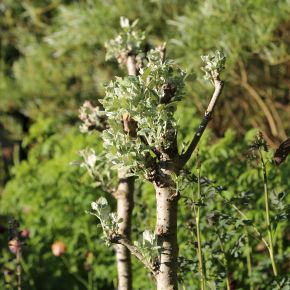Populus alba
(White Poplar)
Family - Salicaceae
Category - Tree
Origin - Central and Southeastern Europe, Central Asia
Season of Interest - Spring, Summer, Autumn
Hardiness - H6
Height - 20m if left unpruned
Width - 15m if left unpruned
Location - The Cool Garden
Description: If left unpruned, Populus alba will form a large, suckering Deciduous tree with spreading branches and pale grey bark and can be used effectively as a windbreak. At Malverleys it is used as a cut-back plant to maintain the appearance and size of the foliage on young trees, and also to control the overall size. Ovate to rounded leaves are variable in shape and have pinnatifid to palmate lobing and wavy margins. The young stems and leaves are covered in white wool and if pollarded, this feature will be retained. If left to grow, the leaves will turn to dark green on the upper surface with the distinctive white wool retained on the undersides of the leaves.
Populus alba is Dioecious (male and female flowers are produced on different plants). Red flowers on male plants or green flowers on female plants are held in pendent catkins and produced in early spring. The female flowers will be followed by white fluffy seed in late summer.
The foliage will turn yellow in autumn before falling.
Flower:
Dioecious (male and female flowers are produced on separate plants). Red flowers are produced on male plants and green flowers on female plants. The flowers are held in pendent catkins in early spring. On female plants, the flowers (if pollinated) will be followed by white fluffy seeds.
Flower colour: Red, green
Flower shape: Catkins
Flowering time: March
Foliage:
Ovate to rounded leaves are variable in shape and have pinnatifid to palmate lobing with wavy margins. The young stems and leaves are covered in white wool, if left unpruned the leaves will eventually turn to dark green on the upper surfaces with white wool on the undersides. The leaves are Alternately arranged along the branches and will turn yellow in autumn before falling.
Foliage Senescence: Deciduous
Foliage Shape: Rounded to ovate with pinnatifid or palmate lobing
Autumn Colour: Yellow
Propagation:
Cuttings, suckers.
Cultivation:
Best in full sun in most garden soils. If planting in clay soil, avoid planting too near buildings.
